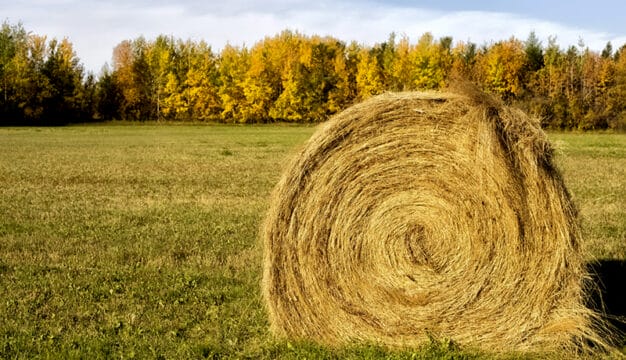Insects of Alabama
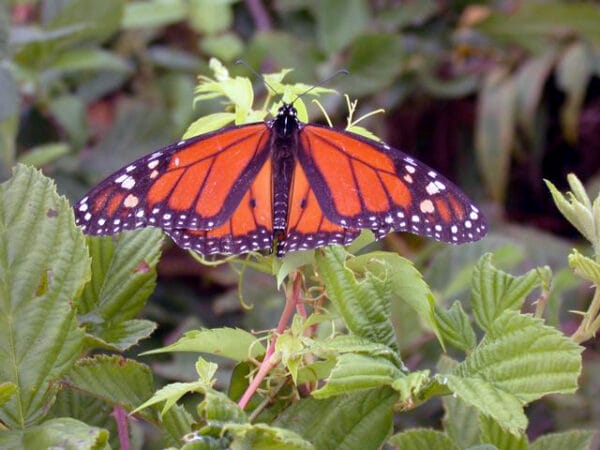 Monarch Butterfly
Alabama is home to a diverse insect community. Thousands of species have already been described, and there are undoubtedly many yet to be discovered. Insects are critical to the proper functioning of Alabama’s ecology. They are also extremely important to the economy of Alabama. Pollinating insects drive the agricultural industry, providing a major source of income to many Alabama families.
Monarch Butterfly
Alabama is home to a diverse insect community. Thousands of species have already been described, and there are undoubtedly many yet to be discovered. Insects are critical to the proper functioning of Alabama’s ecology. They are also extremely important to the economy of Alabama. Pollinating insects drive the agricultural industry, providing a major source of income to many Alabama families.
Insects belong to the phylum Arthropoda, which includes crustaceans such as shrimp, crabs, and pillbugs; chelicerates such as spiders, mites, and scorpions; millipedes; centipedes; and six-legged invertebrates known as hexapods. The class Insecta—the “true” insects—is found within the subphylum Hexapoda. Class Insecta is divided into wingless and winged insects. The only group of true wingless insects is Thysanura, which includes the bristletails and silverfish. Most people are familiar with silverfish, as they are often pests in homes. All other insects either have wings or are descendents of organisms with wings. These insects can be divided into three main groups: Paleoptera, Neoptera, and Endopterygota.
Paleoptera
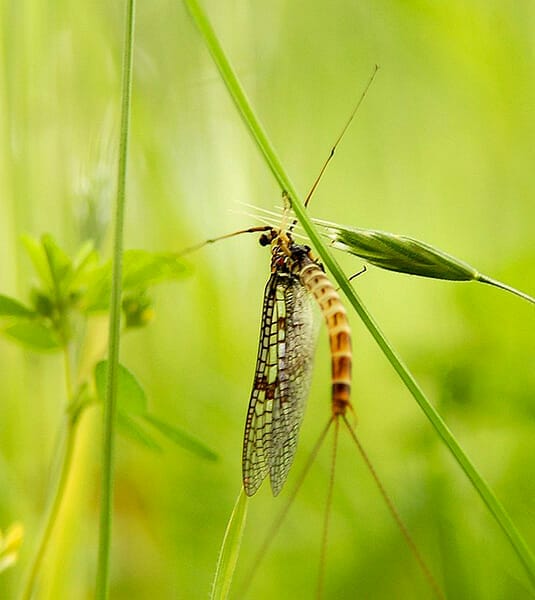 Mayfly
Orders that make up the group Paleoptera include the mayflies (Ephemeroptera) and the dragonflies and damselflies (Odonata). Insects in Paleoptera are distinct from the other two main groups because they cannot lay their wings flat against their bodies. The name of this group literally means “ancient wing” because the wings have no folding mechanism. Mayfly wings differ from dragonfly wings in that mayflies have larger front than hind wings. Odonate wings are similar in size.
Mayfly
Orders that make up the group Paleoptera include the mayflies (Ephemeroptera) and the dragonflies and damselflies (Odonata). Insects in Paleoptera are distinct from the other two main groups because they cannot lay their wings flat against their bodies. The name of this group literally means “ancient wing” because the wings have no folding mechanism. Mayfly wings differ from dragonfly wings in that mayflies have larger front than hind wings. Odonate wings are similar in size.
There are roughly 3,000 species of mayflies in the world, and they inhabit every continent except for Antarctica. Typically, they are found near bodies of water (where they lay eggs). Mayfly adults do not have mouthparts and are thus unable to eat. They exist only long enough to reproduce. It is not uncommon to see swarms of mating adult mayflies near water.
Dragonflies and damselflies (of which there are about 5,500 species worldwide) do have mouth parts and are important predators usually found near bodies of water. Odonate species are found in every area of the world except the Poles. Their diet consists mostly of insects, but immature odonates can consume small fish and tadpoles as well. Oftentimes, two odonates can be seen flying on top of one another for several days while mating. Adults in both orders lay eggs in or near water, and the young, known as naiads, must live either in or near water. Mayflies are particularly pollution-sensitive in this aquatic stage, and their presence is a useful indicator of high water quality. Lifespans of dragonflies and damselflies vary greatly. Naiads can live from six months to five years depending on climate and food availability. Adults can live from one month to a year.
Neoptera
All species in this group are able to lay their wings flat against their bodies. Orders in this group include Plecoptera, Orthoptera, Phasmida, Dermaptera, Dictyoptera, Psocoptera, Phthirpatera, Thysanoptera, Homoptera, and Hemiptera.
Stoneflies (Plecoptera) (with about 2,000 species worldwide) are the only insects in this group with an aquatic naiad stage. They usually live in cool running water or in lakes and, like mayflies, are a good indicator of high water quality. During the mating season, males and females can be heard drumming on the ground with their bodies to attract each other. Stoneflies live on every continent except Antarctica.
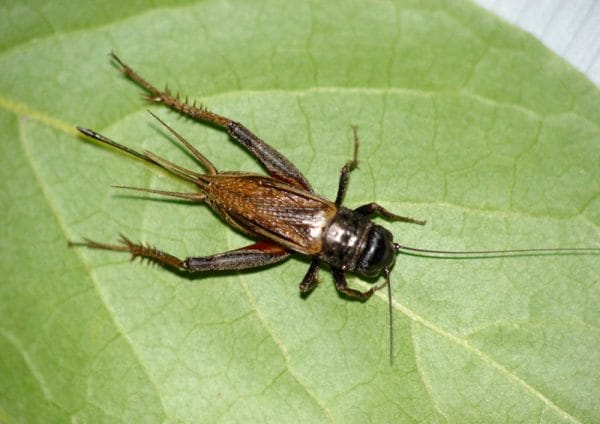 Southeastern Field Cricket
Orthoptera is a very large order of insects (approximately 20,000 species) that includes crickets, grasshoppers, and katydids. Species appear on every continent except Antarctica and can be found in a variety of habitats, from wetlands to prairies to mountain tops. All species have two pairs of wings. The front pair, the tegmina, are leathery and thick, and the hind pair are thin. Most species are able to create sound with various body parts by a process called stridulation. The common southeastern field cricket (Gryllus rubens), for example, rubs its front wings together to create sound; it lays its eggs in soil or rotting wood.
Southeastern Field Cricket
Orthoptera is a very large order of insects (approximately 20,000 species) that includes crickets, grasshoppers, and katydids. Species appear on every continent except Antarctica and can be found in a variety of habitats, from wetlands to prairies to mountain tops. All species have two pairs of wings. The front pair, the tegmina, are leathery and thick, and the hind pair are thin. Most species are able to create sound with various body parts by a process called stridulation. The common southeastern field cricket (Gryllus rubens), for example, rubs its front wings together to create sound; it lays its eggs in soil or rotting wood.
Insects in the order Phasmida are commonly called stick insects. All five Alabama species are wingless. Phasmids are commonly found on tree trunks and blend in well with the bark. Their diet consists of leaves, and they are generally found in tropic and sub-tropical areas. In many species, there are no known males, and they reproduce through parthenogenesis, a type of reproduction in which unfertilized eggs develop into larvae, with only females being born. In other species, males spend most of their lives riding on females’ backs. Lifespans range from several months to three years.
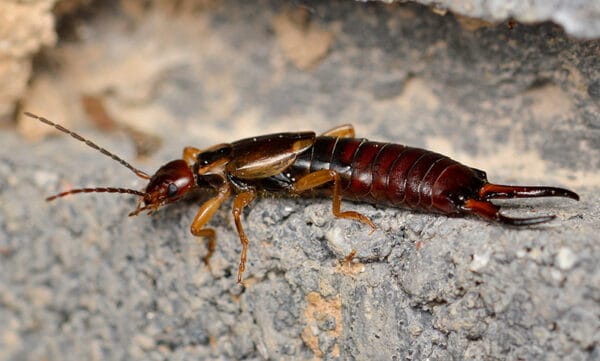 Common Earwig
Earwigs (Dermaptera), with about 1,200 species worldwide, are small insects with a pair of pinchers on the rear end of their bodies that they use to defend their young. Their front pair of wings, called elytra, are hardened and only cover about one-third of their body. Earwigs generally live in leaf litter and under logs. They are found all over North America but are most prevalent in the southeastern United States. Earwigs feed at night on the foliage of various flowers and garden plants. Most species prey on other insects and supplement their diet with decaying organic matter found in soil or garbage. In addition to consuming aphids, beetle larvae, and maggots, earwigs also eat seeds of grain but they can also survive inside homes, where they may become a nuisance. They crawl into anything that is on the ground or the floor and then pinch with their forceps if they are touched.
Common Earwig
Earwigs (Dermaptera), with about 1,200 species worldwide, are small insects with a pair of pinchers on the rear end of their bodies that they use to defend their young. Their front pair of wings, called elytra, are hardened and only cover about one-third of their body. Earwigs generally live in leaf litter and under logs. They are found all over North America but are most prevalent in the southeastern United States. Earwigs feed at night on the foliage of various flowers and garden plants. Most species prey on other insects and supplement their diet with decaying organic matter found in soil or garbage. In addition to consuming aphids, beetle larvae, and maggots, earwigs also eat seeds of grain but they can also survive inside homes, where they may become a nuisance. They crawl into anything that is on the ground or the floor and then pinch with their forceps if they are touched.
The order Dictyoptera contains three suborders: mantids (Mantodea), cockroaches (Blattodea), and termites (Isoptera). Mantids, such as the familiar praying mantis, and cockroaches have tegmina, but termite wings are thin and membranous. Mantids (a group with about 1,500 species worldwide) use their front legs to grasp prey, and their ability to remain motionless and blend into their surroundings while hunting makes them very effective predators. They feed on a wide variety of other insects and arthropods. The well-known story of females eating males is true in some cases but does not happen with every mating. The hungrier the female, the more likely she is to eat the male. The most commonly seen and largest species in Alabama is the Chinese mantid (Tenodera aridifolia), which was introduced from Asia to control insect pests.
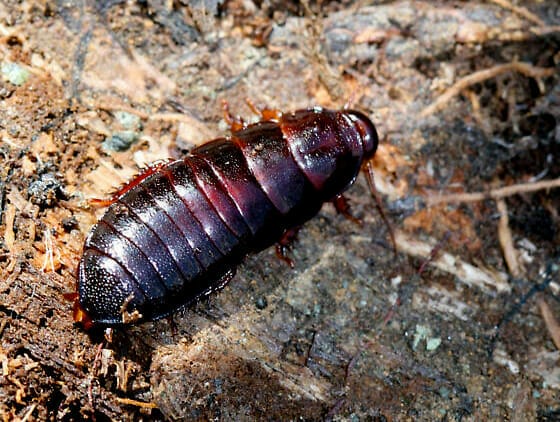 Brown-Hooded Cockroach
Alabama is home to some 25 species of cockroaches that consume various types of organic matter. The German cockroach (Blatella germanica) is the most common indoor cockroach in Alabama and is a household pest throughout much of North America. The brown-hooded cockroach (Cryptocercus punctulatus) is native to Alabama and lives in and consumes rotting wood, which it digests with the aid of microorganisms living in its gut, much like termites. Both brown-hooded cockroaches and termites are beneficial because they assist in decomposition. Termites are found mostly in tropical and sub-tropical regions, where climates are warm and humid. Some species live in drier habitats as well. Approximately 2,000 species exist worldwide. Throughout their range, termites are known primarily as pests. They consume wood structures, such as buildings, telephone poles, and fences, and cause millions of dollars of damage every year. Of termites in Alabama, the exotic Formosan subterranean termite is the most destructive species and is extremely difficult to control.
Brown-Hooded Cockroach
Alabama is home to some 25 species of cockroaches that consume various types of organic matter. The German cockroach (Blatella germanica) is the most common indoor cockroach in Alabama and is a household pest throughout much of North America. The brown-hooded cockroach (Cryptocercus punctulatus) is native to Alabama and lives in and consumes rotting wood, which it digests with the aid of microorganisms living in its gut, much like termites. Both brown-hooded cockroaches and termites are beneficial because they assist in decomposition. Termites are found mostly in tropical and sub-tropical regions, where climates are warm and humid. Some species live in drier habitats as well. Approximately 2,000 species exist worldwide. Throughout their range, termites are known primarily as pests. They consume wood structures, such as buildings, telephone poles, and fences, and cause millions of dollars of damage every year. Of termites in Alabama, the exotic Formosan subterranean termite is the most destructive species and is extremely difficult to control.
Lice are divided into two orders. The Phthiraptera, or true lice, are parasitic on a variety of birds and mammals, including humans. There are about 3,100 species found anywhere there are birds and mammals. They feed on skin, blood, and other body parts. The human louse (Pediculus humanus) is a carrier of epidemic typhus, a deadly disease that killed many during times of war. The head louse, a different form of this species, is common among young children but does not spread disease. The Psocoptera (about 2,000 species), the barklice and booklice, are not parasitic and thus are not classified as true lice. They feed on bindings of old books as well as fungi and mosses. Found on all continents, they are most common in tropical climates.
Thrips (Thysanoptera) (with approximately 5,000 species) are insects with fringed wings that allow them to fly well in humid conditions. They are found on every continent except Antarctica and live on dead branches, leaf litter, green leaves, or flowers. Thrips are parasitic, and many species in this order are responsible for large amounts of crop damage. In Alabama, tobacco thrips (Frankliniella fusca) feed on a wide variety of plants and damage developing leaves. Tobacco thrips also spread the tomato spotted wilt virus to many crops, including cotton and peanuts.
The order Homoptera is very large, with some 32,000 species, and includes cicadas, leafhoppers, aphids, scale insects, and mealy bugs. Insects in this order are found on every continent except Antarctica and in nearly every habitat, both terrestrial and aquatic. Cicadas, leafhoppers, some aphids, and a few mealy bugs have membranous wings.The rest of the insects in this order are wingless. Most of these groups are common in Alabama, but cicadas may be the most well-known in this order. The sound of males calling to females is common during the summer months. Homopterans suck juices from plants and can be crop pests.
The order Hemiptera, the true bugs, is also a very large group (23,000 species) that inhabits every continent except Antarctica and is found in most terrestrial and aquatic habitats. Hemipterans are unique because their front wings are partly leathery and partly membranous. Hemipterans feed on plants, other insects, and blood. One species, the bed bug (Cimex lectularius), feeds on human blood and has made headlines in recent years. Because of increased international travel, bed bugs are becoming more problematic and widespread, particularly in urban settings.
Endopterygota
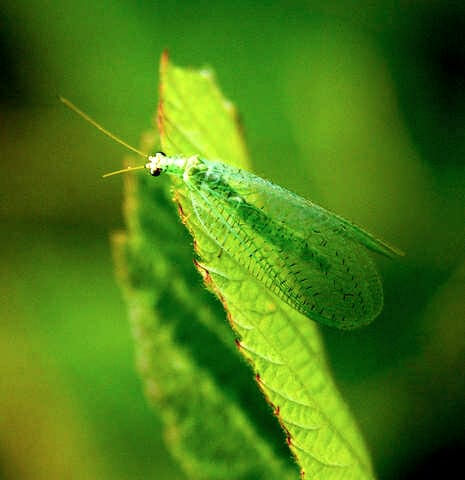 Common Lacewing
These nine orders of insects—Neuroptera, Coleoptera, Strepsiptera, Trichoptera, Lepidoptera, Mecoptera, Siphonaptera, Diptera, and Hymenoptera—have four developmental stages (egg, larva, pupa, adult). They also differ from the previous groups of insects because their wings develop internally.
Common Lacewing
These nine orders of insects—Neuroptera, Coleoptera, Strepsiptera, Trichoptera, Lepidoptera, Mecoptera, Siphonaptera, Diptera, and Hymenoptera—have four developmental stages (egg, larva, pupa, adult). They also differ from the previous groups of insects because their wings develop internally.
Antlions, dobsonflies and lacewings (Neuroptera) (4,600 species worldwide) feed on other insects and are often considered beneficial. Antlion larvae dig cone-shaped pits in the ground and lie in wait for prey (often ants) to fall in. Dobsonflies lay eggs in well-oxygenated, fast-moving streams and as larvae feed mostly on other insects. Adults do not eat. Lacewings, the most common insect in this order, live primarily in forested areas and on crops infested with aphids and mealybugs, which their larvae eat. Adults feed on nectar and a substance known as honeydew excreted by aphids.
 Boll Weevil Monument
Beetles (Coleoptera), with more than 350,000 species, make up the largest insect order and inhabit every continent except Antarctica. Their front wings are elytra and cover the majority of their bodies. Feeding habits range from plants to other insects, and there are both detrimental and beneficial species in this group. The beneficial multicolored Asian lady beetle (Harmonia axyridis) was introduced to Alabama and other states to control aphids, which cause damage to crops and ornamental plants. Both the larvae and the adults feed on aphids. The most notorious member of this order in Alabama is probably the boll weevil (Anthonomus grandis). Native to Mexico, the boll weevil spread across the southeastern United States and devastated cotton crops beginning in the early twentieth century. In response, many farmers turned to other crops and revitalized Alabama’s agricultural economy. To acknowledge this benefit, the town of Enterprise, in Coffee County, erected the Boll Weevil Monument. The Boll Weevil Eradication Program and the spread of the imported fire ant (a predator of the boll weevil) have essentially eliminated this pest.
Boll Weevil Monument
Beetles (Coleoptera), with more than 350,000 species, make up the largest insect order and inhabit every continent except Antarctica. Their front wings are elytra and cover the majority of their bodies. Feeding habits range from plants to other insects, and there are both detrimental and beneficial species in this group. The beneficial multicolored Asian lady beetle (Harmonia axyridis) was introduced to Alabama and other states to control aphids, which cause damage to crops and ornamental plants. Both the larvae and the adults feed on aphids. The most notorious member of this order in Alabama is probably the boll weevil (Anthonomus grandis). Native to Mexico, the boll weevil spread across the southeastern United States and devastated cotton crops beginning in the early twentieth century. In response, many farmers turned to other crops and revitalized Alabama’s agricultural economy. To acknowledge this benefit, the town of Enterprise, in Coffee County, erected the Boll Weevil Monument. The Boll Weevil Eradication Program and the spread of the imported fire ant (a predator of the boll weevil) have essentially eliminated this pest.
Twisted-winged parasites (Strepsiptera) make up a relatively small order (550 species) and are found on every continent except Antarctica. All are parasites on other insects. The winged males die soon after mating, and the wingless females attach to and remain on their hosts.
Caddisflies (Trichoptera) are moth-like insects that lay eggs in fresh water. The aquatic larvae build cases from debris around themselves and feed on anything from algae to invertebrates. They are important in the food web as both consumers and prey. Like Ephemeroptera and Plecoptera, caddisfly larvae indicate high water quality. There are approximately 7,000 species of caddisflies found all over the world except Antarctica.
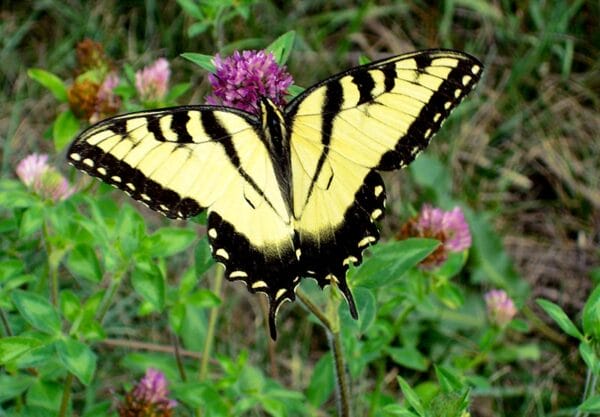 Eastern Tiger Swallowtail
Moths and butterflies belong to the large order Lepidoptera, which contains about 112,000 species. Moths and butterflies are most common in the tropics but are found on every continent except Antarctica. Their larvae, caterpillars, feed on plants and can be economically harmful. Two of the most detrimental species in Alabama are the corn earworm (Helicoverpa zea), which feeds on more than 100 plant species, and the tobacco budworm (Manduca sexta), which feeds on tobacco, tomatoes, and potatoes. Both species have developed resistance to insecticides. Adult lepidopterans, on the other hand, are often beneficial as pollinators. The state insect of Alabama is the monarch butterfly (Danaus plexippus), and the state mascot and butterfly is the eastern tiger swallowtail (Papilio glaucas).
Eastern Tiger Swallowtail
Moths and butterflies belong to the large order Lepidoptera, which contains about 112,000 species. Moths and butterflies are most common in the tropics but are found on every continent except Antarctica. Their larvae, caterpillars, feed on plants and can be economically harmful. Two of the most detrimental species in Alabama are the corn earworm (Helicoverpa zea), which feeds on more than 100 plant species, and the tobacco budworm (Manduca sexta), which feeds on tobacco, tomatoes, and potatoes. Both species have developed resistance to insecticides. Adult lepidopterans, on the other hand, are often beneficial as pollinators. The state insect of Alabama is the monarch butterfly (Danaus plexippus), and the state mascot and butterfly is the eastern tiger swallowtail (Papilio glaucas).
Scorpionflies and hangingflies (Mecoptera) are not very common in the United States. There are only about 80 species in the U.S. and Canada, compared with 550 species worldwide. Most species are found in Southeast Asia and Indonesia. They are most commonly found in shady areas along rivers and near springheads. Although they sound dangerous, they do not sting. Their mouths are modified into broad snouts, and they typically feed on dead insects.
Fleas (Siphonaptera) are a well-known group of blood-sucking insects that live throughout the world. There are about 2,400 species in total, all of which live on either birds or mammals. They are wingless, but they are powerful jumpers. The most commonly encountered flea in Alabama is the cat flea (Ctenocephalides felis), which is the species usually found on cats and dogs.
Flies, midges, and mosquitoes all belong to the order Diptera. With nearly 87,000 species found throughout the world, the species of the Diptera are among the most noticeable groups of pests to humans. This group is unique because the insects’ hind wings are tiny and modified for stabilization during flight. Most species require moist material in which to develop, either standing water, leaf litter, or soil. Feeding strategies vary among the species in this group: some feed on blood, some are parasitic as larvae, and some feed on decaying matter, including dead animals. Several species within the Diptera are beneficial because they are predatory on pest insects, including the tachina fly (Archytas marmoratus), which feeds on the corn earworm. The most common mosquito in Alabama is the Asian tiger mosquito (Aedes albipictus). It was introduced to the state in the 1980s and is responsible for spreading West Nile virus.
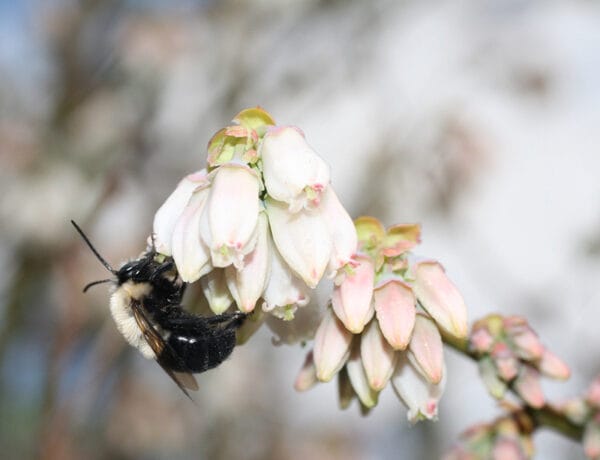 Southeastern Blueberry Bee
The final order of insects, Hymenoptera, includes ants, bees, wasps, and sawflies. There are approximately 105,000 species found throughout the world except Antarctica. Habitat preference varies widely among this group and includes soil, leaf litter, herbaceous plants, and trees. Many members of this order are extremely beneficial. For example, the honey bee (Apis mellifera) is economically important for its production of honey. Another species, the red imported fire ant (Solenopsis invicta), is typically regarded as a nuisance, but these animals prey on boll weevils, bollworms, and ticks, all of which are pests in Alabama.
Southeastern Blueberry Bee
The final order of insects, Hymenoptera, includes ants, bees, wasps, and sawflies. There are approximately 105,000 species found throughout the world except Antarctica. Habitat preference varies widely among this group and includes soil, leaf litter, herbaceous plants, and trees. Many members of this order are extremely beneficial. For example, the honey bee (Apis mellifera) is economically important for its production of honey. Another species, the red imported fire ant (Solenopsis invicta), is typically regarded as a nuisance, but these animals prey on boll weevils, bollworms, and ticks, all of which are pests in Alabama.
Further Reading
- Abbott, John C., and Kendra K. Abbott. Insects of North America. Princeton Field Guides Vol. 157. Princeton, N.J.: Princeton University Press, 2023.
- Daniels, Jaret C. Garden Bugs & Insects of the South & Southeast: Identify Pollinators, Pests, and Other Garden Visitors. Cambridge, Minn.: Adventure Publications, 2021.



